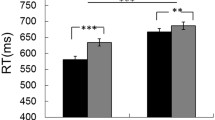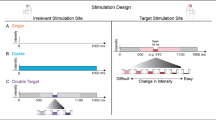Abstract
Inhibition of return (IOR) refers to the slowing of responses to stimuli presented at the same location as a preceding cue. However, the cue-target paradigm used in most previous studies may have overestimated the contribution of eye movement programming to IOR, due to the existence of manual response inhibition effects. This confound can be circumvented by using a target-target paradigm in which participants respond to all stimuli. Here, we compared IOR magnitude from tactile cue-target and target-target tasks involving identical interstimulus intervals of 1,400 and 1,800 ms. Reaction times were measured using a foot pedal toe-lift response and a vocal response. Tactile IOR was observed using both modes of response, demonstrating IOR for the first time using a non-spatial, vocal response. Moreover, IOR effects were significantly smaller in target-target compared to cue-target conditions, thereby confirming the existence of the response inhibition confound.
Similar content being viewed by others
Author information
Authors and Affiliations
Corresponding author
Rights and permissions
About this article
Cite this article
Poliakoff, E., Spence, C., O’Boyle, D.J. et al. Tactile inhibition of return: non-ocular response inhibition and mode of response. Exp Brain Res 146, 54–59 (2002). https://doi.org/10.1007/s00221-002-1153-2
Received:
Accepted:
Published:
Issue Date:
DOI: https://doi.org/10.1007/s00221-002-1153-2




